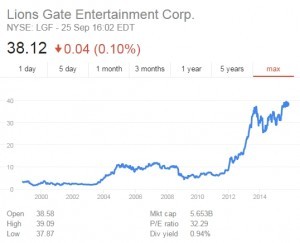Erik Qualman's Blog, page 514
October 5, 2015
4 Gadgets You Can Use to Do Your Social Media Marketing on the Go

One of the greatest things about being in charge of the social media marketing for a company is the flexibility. You can work basically anytime, anywhere to accomplish your tasks. You can even work while you’re on vacation! Just imagine leaning back in a lounge chair with your toes in the sand, sipping an ice cold beverage with the soothing sound of ocean waves in the background. Not many people can say that’s their office view, even if it’s just for a few days.
All you have to do is get the right gadgets, and luckily for you, there are hundreds of tools you can use to complete your work, which makes being a social media marketer a piece of cake.
As a word of caution, note that these devices power your ability to be totally flexible. A social media marketer is only as good as their devices, and for that reason, it’s imperative that you keep these items protected. Look into device protection plans that will cover your devices beyond the manufacturer’s flimsy warranties. An out of commission phone or computer could cause serious problems to you as a social media marketer, so make sure you’re prepared.
As you choose your set of travel-friendly gadgets, consider that the right gadgets will be able to seamlessly integrate wirelessly. That way, if you have things stored on one device, you’ll be able to access them easily, even if you’re not near that particular machine. Apple leads the market with this capability. They offer seamless integration and a whole world of apps to use to make life easier. If you’re looking for some great social media savvy devices with the power to interconnect, check out this list.
1. iPhone 6 Plus
This phone may be expensive, but it’s wired to be a social media hub. One thing that makes it such a useful tool is the large screen. The screen is 5.5 inches, but the whole device is only 7.1 mm thick, making it one of the thinnest smartphones on the market. The size makes it perfect for attending to social media needs as well as easily staying connected to the office. It’s also water resistant, which is important while traveling, since protection is key.
2. iPad
If you want to make the switch to a tablet to do your work, the iPad is a great choice. Though any tablet will do for completing your social media tasks, Apple is probably the best thanks to its widespread integration. It has the largest number of apps of any network, which means you can connect more social networks and utilize a larger number of tools when using this device.
3. Apple Watch
Though you’ll want to reserve some of the larger tasks for later, the Apple watch is a great way to check notifications on the go. You can easily read and reply to comments, as well as post something simple to your page. It’s great for staying connected, especially when you’re somewhere that you can’t pull out your mobile device or tablet.
4. Macbook Air 13 Inch
Once again, we have an Apple product that’s deemed the best of the best. The Macbook Air is perfect for social media marketers because it’s small, lightweight, and easy to travel with. It also has an exceptionally long battery life and the capacity to hold large programs for photo editing and meme building (such as the Adobe Suite).
With all of these devices, you’ll be able to stay interconnected with your social media responsibilities at all times without a problem. This gives you the flexibility to accomplish your tasks in any setting.
As a side note, you don’t need to use all Apple products to stay connected. It’s true that Apple has the best cloud integration and the largest variety of apps on the market, but if it’s not in the budget for you to choose these devices, there are alternate options.
The important thing is to be able to stay connected, and these gadgets will help make that possible for you as a social media marketer.
[image error]
Social Media for Financial Investors

When it comes to the world of finance, timing is absolutely critical. Making effective investments involves staying a step ahead of the competition and the rest of the market.
Historically, investors made their decisions based on trade publications, tip offs from contacts and more traditional media. However, in the digital age, these are becoming redundant due to the rise of social media, and investors can now obtain information more quickly, easily and efficiently than ever before.
Twitter, for example, has overtaken both traditional and online press to become the most up-to-date news source on the planet, with a plethora of massive, worldwide stories breaking on the platform before any other media source.
In an industry where even the slightest delay can cost millions of dollars, this level of immediacy is crucial.
With this in mind, there are three main ways investors can utilise social media:
Predicting future market movements
Gauging public sentiment
Connecting to obtain further industry insight
Predicting future market movements
Firstly, social media is a fantastic tool for predicting financial movements before the rest of the market. When obtaining breaking news and observing developing trends ahead of the competition is so critically important, social media offers investors a significant advantage.
The reason for this is the insight into trending stories that social media provides. Twitter is one of the best tools in the world for spotting upcoming developments, with a constantly updating Worldwide Trends tab on the homepage and multiple accounts about trending topics set up.
These tools allow shrewd investors to predict changes in their markets and invest appropriately to ensure they benefit. One of the best case studies of this involves Lions Gate, the film studio behind the worldwide Hunger Games franchise.
Before the release of the first movie, several investors noticed that there was a massive increase in interest in Hunger Games relevant hashtags. Seeing the potential of a Harry Potter-esque phenomenon, these investors bought stocks in Lions Gate, which were trading on the NYSE at the time at 14.53.
Now, with the fourth film in the wildly successful series imminent, Lions Gate shares are at 38.12, representing a 162% increase since the first movie’s release in March 2012. The franchise is now one of the top twenty highest grossing in the history of cinema, which is something these investors forecast and profited from, solely as a result of social media.
Gauging public sentiment
Public sentiment is a crucial factor for investors to consider; if there is excitement, anger or even apathy about an upcoming event that will affect share prices, they need to know about it.
Tammy Poon, from financial services provider Spread Co, says, “Those in the industry should pay close attention to how a story is perceived – has it got shares or favourites?” These additional social metrics can provide insight into how markets will develop.
In fact, according to research from Arthur O’Connor, a post-doctoral student from Pace University, almost 100% of share price changes can be explained by social media sentiment. He examined share prices of top brands over ten months, then cross-referenced them with their number of Facebook Likes, Twitter followers and YouTube views across that time period.
What O’Connor found was that 99.95% of positive or negative stock movements were an accurate reflection of positive or negative changes in these social measurements.
He says, “Brand following as expressed by fan counts on social media networks might serve as predictor of increased revenues, earnings and (thus) stock prices of brand companies. The results [of the research] offer considerable significance in the fundamental analysis and forecasting of brand companies and their stock prices.”
Data Sift carried out similar research looking into public sentiment at a more granular level, this time focusing specifically on the Facebook IPO.
They looked into how public sentiment, either positive or negative, on Twitter affected the initial Facebook stock price. Data Sift found that there was between a four and twenty-five minute delay, followed by a change in stock price that was very much in line with any major shifts in sentiment.
Both of these experiments show that public sentiment displayed on social media platforms is an extremely important factor for determining stock market prices. This is quantifiable proof of the importance of using social media in the finance world; those investors who choose to continue to shun it are now putting themselves at a severe disadvantage.
Connecting to obtain further industry insight
One of the oldest and most relied-upon techniques for stock market success is building a diverse and robust network of contacts. Connecting with influential and knowledgeable people in various industries gives investors an enormous head start and this is really where social media comes into its element.
Platforms like LinkedIn and Google+ allow professionals to connect and network in a way that is faster and more efficient than ever before in business. In fact, LinkedIn has proved itself so useful in this field that 73% of investors now use it to broaden their networks and research future deals.
With the option to group connections with specific tags, LinkedIn affords fantastic opportunities to organize contacts. Zak Mir, editor at leading trading publication Spreadbet Magazine, says that if investors connect with “the right twenty to thirty people in the trading and financial markets area, then they should be fully informed in terms of what to think, what to trade, and when to trade it”.
In addition to connecting with industry big hitters to receive the most up-to-date insight and tips, LinkedIn is also a good tool for investors interested in particular markets. The best brands on the platform publish a stream of regular, high quality professional content, which can further increase awareness of future market movements.
Overall, social media has become an invaluable tool for investors. It has overtaken traditional media to become the most instantaneous news source on the planet, proved to be an accurate predictor of stock market movement, and evolved into the fastest and most efficient way to organise robust networks of influencers.
Put simply, it gives investors the edge and has made itself impossible to ignore.
[image error]
Jack Dorsey Officially Named Twitter CEO

THE STORY – Jack Dorsey Officially Named Twitter CEO
Last week it was up in the air whether or not Dorsey and Twitter would be staying together. It was announced on Monday morning that Dorsey will permanently be the CEO. (Source: CNN)
What to say when people are giving you shade…
Dorsey is also CEO of Square. His position as CEO for both companies had many unsure about how his performance would be. Dorsey has been telling people not to worry about it because he has it covered. Dorsey tweeted today, “I’ve been CEO of both companies for over 3 months now. I have the smartest, strongest, and most determined leaders in the world on my teams.” (Source: CNN)
DA SKIM
Dorsey has a lot of work cut out for him considering Twitter’s stock dropped 25% this year. Reports show that Twitter does not intend to compensate Dorsey for his CEO title but Dorsey seems to be okay with that. He does own a $575 million stake in the company. You can tweet him good luck @jack. (Source: CNN)
Quote of the Day: “Do the right thing”
Remember over the summer when Google announced a change in their structure and that Alphabet would be their new parent company? Well that change happened on Friday. The big change that has people talking is the removal of the infamous “Don’t be evil” from the new parent company’s code of conduct. Before the search engine went public, Sergey Brin and Larry Page had dubbed “Don’t be evil” as the unofficial motto of Google. Alphabet has replaced this in their code of conduct with “Employees of Alphabet… should do the right thing – follow the law, act honorably, and treat each other with respect.” That’s a good message too, but don’t be evil sounded better. (Source: Fortune)
[image error]
Are Your Podcasts Social Enough?

No matter your profession, you know the importance of promotion through social media. But what is just as important, is the cross-promotion and hitting up all avenues of social media.
There may be some venues that you haven’t thought of yet, and these can be incorporated to your other forms of social media.
Let’s take a look at podcasts.
Not everyone is aware of the importance and benefit of incorporating podcasts into their marketing strategies. However, podcasts have their own realm of benefits and adding them to your marketing efforts is a smart idea.
The article, “7 Stitcher Podcasts Any Insurance Agent Will Benefit From” shares not only some reasons why podcasts are so important, but some good ones and why they are successful.
And yes these are geared towards insurance agents, but the ideas translate to any profession.
Here are some of the benefits:
• Podcasts show expertise – Whereas a tweet or text message is a great form of marketing for a quick update or call to action, a podcast can offer expert information in a detailed, thorough format on any aspect of your company and field;
• Podcasts promote engagement – When you spend time listening to a podcast, whether in your car or at the gym or cooking dinner, you develop a bond with the podcaster. You can usually subscribe to the podcasts so they can become part of your routine;
• Podcasts provide education – This education becomes threefold because not only does your audience (clients and customers) benefit from it, but so does whoever is doing the podcast and the company itself.;
Incorporating Social Media to Promote Podcasts
To put social media and podcasts together, remember:
• When a new podcast is released, let your SMS and email subscribers know;
• Use other forms, like Twitter and Facebook, to promote podcasts. You can use this platform to promote new podcasts as well as to re- promote one that may be older but currently relevant;
• Upload your podcasts to iTunes;
• Share a visual on Pinterest or Instagram and link it to your podcast.
Consumers and Clients Are on the Go
With as much time as people spend in their cars and other places where the best medium for information is audio, it makes sense to incorporate podcasts to your efforts.
Your clients can listen in the car, at the airport, while working out, running errands, walking the dog – pretty much anytime. Yes, other forms of social media are all important, but so is this audio aspect.
Add it to your marketing rotation and watch as the benefits abound.
Lastly, don’t forget to promote through social media!
Photo credit: BigStockPhoto.com
[image error]
October 2, 2015
5 Organizational Tips Essential for a Successful Social Media Campaign

When you’re looking to carry out a successful social media campaign, it’s important to look at things other than your metrics and overall strategy. You’ll also need to think about how your marketing plan will be executed. If your internal procedures and policies are a mess, you’ll have a hard time putting in the energy necessary to make your social marketing succeed.
Productivity and organization within a group structure aren’t always easy to master, but they’re vital for a fruitful social strategy. Here are some of the best ways to make your social marketing campaign more efficient, productive, and organized.
1. Build Meaningful Relationships Among Employees
You often hear that the best way to succeed in the social world is through building meaningful relationships with your social followers, and that’s true. But a great social marketing strategy actually starts with your employees. Both coworkers and leaders will need to work together to establish a strong bond that can keep them working efficiently and productively through the social process. If things aren’t harmonious between employees, your social strategy will suffer, and extra training and trust exercises will become necessary to improve employee relationships.
2. Integrate Passion with Your Purpose
One of the main reasons that social strategies fail is lack of passion. Followers can detect when those running the social show are not passionate about their mission. Understated enthusiasm comes from several things, including employee disagreements and inadequate training on the overall purpose. Turn the tables and make sure that your employees are as excited about your mission as you are. If need be, change the working environment or offer company incentives to help them dive into the campaign headfirst.
3. Offer Comprehensive Employee Training
Employees need to be trained in multiple areas to succeed online, not just in the policies and procedures of the company. For well-rounded, independent employees, they’ll need basic coaching in areas such as network administration, programming and development, and IT soft skills. Many companies can’t give up the time or money to offer weekly trainings in these areas. “The reality is there are just too many hard-to-control variables when maximizing live employee training,” according to an article from CBT Nuggets, training professionals. Instead, focus on incentivizing employees to do online personal trainings so they can learn the necessary skills to get the job done.
4. Connect and Collaborate
It’s important to stay connected, not only with your social following, but also with your marketing team. Smooth collaboration and a constant digital network are essential for seamlessly connecting with followers. To make sure this works effortlessly, begin by relying on strong networks and high quality tools and resources. Project management programs and other time tracking tools help to keep everyone connected at all times.
Also, work on connecting socially with your employees. Employees are more likely to work harder if they actually like the people they’re working with. Make personal connections with those around you to help promote efficiency with your social campaign.
5. Utilize Digital Tools
Remember that the internet is your playground for all things social media. There are thousands of tools that can help to boost the productivity of your social media campaign. For example, imaging websites are helpful for providing photos free of copyright and sizing issues while other tools are available for monitoring your social pages and driving more traffic and engagement.
Likewise, these tools can be useful for tracking, measuring, and adjusting your efforts in your campaign. Test out what works and learn what doesn’t so that you can understand the things that grab audience attention, as well as the things that get ignored. From there, you can adjust your efforts instead of wasting time on things that don’t work.
Success in social media takes careful planning and organization. Thanks to today’s network of digital connectivity, everyone has the tools to do just that. Committing to daily habits of organization and efficiency is the best way to succeed in social media for businesses.
[image error]
Jack Dorsey Could Be Twitter CEO…Again

THE STORY – Jack Dorsey Could Be Twitter CEO…Again
Twitter Co-founder, former CEO, and current interim CEO Jack Dorsey could take over as CEO of Twitter. Dorsey was just doing Twitter a solid and taking over while they did some recruiting but Dorsey is looking for more of a long term relationship with the social media site. (Source: ABC News)
What to say when you’re dating two people…
Dorsey has been staying busy. He is currently the CEO of payment processing app, Square which means that if he takes over as Twitter CEO (again) he will be balancing two jobs (again). Sounds a little overwhelming but Dorsey says it’s chill, he has done it before. (Source: )
DA SKIM
The final decision on if Dorsey and Twitter are going to stay together long term will be decided once the board votes on whether or not they think Dorsey should get another chance. (Source: )
Quote of the Day: “Obviously I am incredibly angry about this data breach”
That’s what T-Mobile Chief Executive, John Legere, said yesterday after millions of customers had personal data stolen. Like 15 million customers. Consumer credit monitoring firm, Experian, disclosed the breach on Thursday. Experian discovered that data was taken from one of their servers on September 15th. Experian is offering credit monitoring to those affected but TBD if people will trust them after just having a breach. So many breaches that some consider being hacked the new black, Kale or Sriracha Sauce – it’s hot, not. (Source: Reuters)
In case you missed it…
The Internet loves memes. With Hurricane Joaquin threatening to ruin everyone on the East Coast weekend plans, social media users have taken to their meme generators and created this:

(Source: Twitter)
[image error]
Five Things to Know About Stripe’s New Relay API

A version of this article first appeared on the BLASTmedia blog.
On Monday, payment processing company Stripe Inc., launched Relay, a set of APIs for building in-app buying experiences. With Relay, people can buy products directly within an app — like Twitter, ShopStyle or even your own company’s app — rather than getting pushed to third-party websites.
If you’re not already excitedly Googling “Stripe Relay” with baited anticipation of how you can use Relay for your business, here are four other really cool things any marketer should know about Relay:
#1: Anyone can now sell stuff on Twitter directly in the app.
Twitter is one of Relay’s launch partners and everyone from Reuters to Fortune is talking about how Stripe is allowing merchants to turn Tweets into storefronts. However, unlike some offerings that appear in Beta to a group of select users first, Warby Parker and other big brands aren’t the only brand that can use it. You can actually set up Stripe Relay account (or just check out the interface) right now.

#2: You don’t need to be an app developer to use it.
As Marcus Wohlsten points out in his recent article for Wired, “you don’t have to know what an application programming interface is to appreciate what Stripe’s new Relay API can do.” The API is already integrated with Twitter, which means that anyone with a Stripe account — even the app dev challenged — can build a virtual catalog.
#3: Twitter isn’t the only launch partner.
In addition to Twitter, other Relay launch partners include Inmobi, ShopStyle and Spring. According to TechCrunch, “app developers who integrate with Inmobi can enable Relay purchases in apps rather than pushing them to mobile sites.”
#4: Relay isn’t just backed by cool partners, but by a company with sticking power.
Relay isn’t Stripe’s first foray into online payments, it’s how the business was built. Although it might still be considered a startup, but earlier this year Stripe raised $5 billion from investors including a few who also know a thing or two about online payments: Visa and American Express.
#5: Retailers have already uploaded 4 million products to Relay.
As for the impact on mobile app development, the trend of social purchases, and overall mobile revenue? It’s still too soon to tell. However, for companies struggling to monetize their online presence or make the move from desktop to mobile e-commerce, Relay looks like one to watch.
[image error]
October 1, 2015
Go with Social Media and Lighten Your Load

Decluttering – the word may strike panic in the hearts of some, while others may get a rush when they hear it.
Whichever camp you fall into, it may be time to get rid of some of your household junk.
Your rooms are overcrowded, your garage is bursting at the seams – it’s time to clear out. But where is it going to go?
Social Media is Your Friend
Let’s say you’ve sorted and bagged and organized it all. Now what? Should you donate, sell, give to friends? A combination?
When you’re a little stuck here, turn to social media as the following article looks at to help you find a new home for your discards and figure out “How to Safely and Efficiently Get Rid of Your Household Junk.”
Among the options:
Donations:
When you are looking to donate, you can look to some social media sites to find the best place to send your giveaways.
You may decide to send it to a shelter, a non-profit who will resell, a school or church, depending on what you have. Clothing and blankets are always needed at shelters, books and gently used school supplies are great to send to schools.
Check out any social media some of the places may have to find a new home for your things.
Remember, if things are in really poor condition, it may be better to send them off to the trash, but if your discards are still in good condition, people will be grateful to have them.
Selling:
You can sell in one of two ways – list on sites like eBay or Craig’s List, or sell in one fell swoop, as in a garage sale.
If you’re doing a garage sale, you need to get the word out. Let your social media followers know about it. Post a few days before and the day of.
You can share pictures of some of your stuff so people know what you’ve got. Ask for shares to let more people know. Social media is a great tool for getting the word out on garage sales.
Even if you’re not going so far as a garage sale but have a few things you’d like to get some money for, put it on social media.
You never know what friend may need that gently used swimmer’s parka or coffee table….
Giving to Friends:
Another option is to give to those you know instead of donating to a local charity.
Maybe your kids are out of the toy stage or you have some tennis equipment you don’t use anymore. You know some people who could use it. Turn to social media for this.
From messaging individuals to adding a pic and a post, you may find a new home in an easy way.
You can also set up pick up through social media. Remember, when dealing with people you know it’s fine to set pick up at your house, but if you don’t know them, find a neutral, safe venue.
Many police stations are setting aside times in their parking lots for sales like this. You can probably find this on social media!
Getting rid of your junk can be a glorious thing.
Remember, one person’s junk can be another’s treasure.
Photo credit: BigStockPhoto.com
[image error]
Big News Shoppers

Big News Shoppers
Twitter is making shopping a whole lot easier with their Buy button. On Wednesday, Twitter announced their recent partnership with ecommerce companies Shopify, Bigcommerce, and Demandware. This is big news for any retailer big or small that wants to sell to consumers via social media — retailers can use any of Twitter’s new partners to power its e-commerce offerings & use the Buy button to put their products on the site. This new installment also offers merchants access to Twitter product pages.
Nathan Hubbard, Twitter’s head of commerce, recently commented, “To date, we’ve been testing with a very small group of merchants to try and get a sense of what works, we’ve now broadened the number of merchants that can sell on Twitter from hundreds to millions.” Folks the Buy button is here to stay so make sure to not drive and buy. (Source MSN)
Yelp for Your Neighbor…
People everywhere are counting down the days till the Yelp like service “Peeple” is up and running. What’s all the fuss about? Peeple is the service that allows users to assign reviews one-to five stars to people. Think about your old noisy neighbor, your ex, or basically anyone you’ve ever been in contact with, and being able to write a review about that person.
Also did we mention you CAN’T opt out, and you can’t delete bad or biased reviews. Once someone posts a review about you and it’s in the Peeple database, it’s there unless you violate the terms & conditions. Positive reviews are posted right away, and negative reviews are given a 48-hour window to dispute (Phew, sigh of relief). Peeple co-founder Julia Corday quotes “It’s feedback for you, so use it to your advantage!” Reviews for people are the future and we don’t want to say we told you so but, hmm we kind of did. Check out our thoughts on ratings here. (Source MSN)
Happy October
October 1st is the 168th birthday of women’s rights activist Annie Besant. She is famous for founding one of the largest schools in India, and her contributions towards India’s independence from the United Kingdom.
[image error]
Why e-mail marketing is an effective tool to increase your sales

Many people struggle to answer the question “Which internet marketing tool is the most effective?”. Most of them (even marketing specialists) believe that there is actually no correct answer. But yet, they are wrong.
SeeWhy (Now Hybris) conducted a research in which they analyzed more than 60 thousands transactions from different sites and here are the results:
56,8% of all the purchases were done thanks to email-marketing;
17 ,9% of all the purchases were provoked by direct entries to the site;
10,3% – search engine queries;
4,8% – contextual advertising;
4,3% -social media.
As you can see, even though new generation of internet marketing specialists often deeply believe, that email-marketing is a “thing from the past” and social media provoke more sales, digits speak for themselves. Email-marketing is still the most effective way to sell things on the internet.
SPAM and email-marketing
Those two terms are often confused, so to be clear:
SPAM – is a newsletter that no one wants to receive, even if it is distributed among some composed list of users.
Email-marketing is a newsletter sent to users who agreed to receive those letters. So, basically they are interested in product or service you sell. That is the reason why conversion is so significant.
The proper way to use it
Email-marketing however is targeted more on developing relations with already existing clients in order to sell them more, rather than luring new ones.
For example, when you order a coursework from Edusson.com, you are proposed to sign into a newsletter in order to get notifications about future discounts and special offers. If you are a student, who orders a lot from this site, you will probably agree to be aware of possible beneficial propositions. Obviously, you will be ready to buy from them when you will need it.
This is just one of examples, of how email-marketers work. Clearly, they do not use only this approach. Some of them later add a complex system of recommendations to tell you about some other product or service that may interest you. Like, when you order a book from Bookdepositary.com, they will send you a story about other books that might interest you.
Make them love your letters
Offering products and discounts are far not the only way email-marketing is used. It is important to make people read and even enjoy your newsletter.
Sending different tips or smart ways to use a product that has already been purchased is a great way to do it. If your client knows that he or she will surely find something interesting in your letter, you may feel free to offer him or her to buy something from you and chances that they will do it are quite high.
Personalization
Every letter from you should personalized. It is not a problem at all to track, what interests particular person, depending on what they ordered or added to bookmarks.
Using this information you can optimize your newsletters for their needs.
Email-marketing software
There are many sites, that provide tools for email-marketing. Here are some of them:
Campaign Monitor
MPZMail
G-Lock EasyMail7
MailChimp
They do not only provide tools for composing great persuasive letters. They also provide various services for tracking how your clients perceived them. You can see, what percentage of your followers clicked particular links in the text, or how much time did they spend reading it.
Unlimited opportunities for doing researches.
Once again, email-marketing is not SPAM
You should firstly receive a permission to send your letters, and only after you start mailing people. Only such approach will give you some results. In any other case, your newsletter will be ignored and user will have negative associations with your site. If that happens – there is no way they would ever buy anything from you.
[image error]





